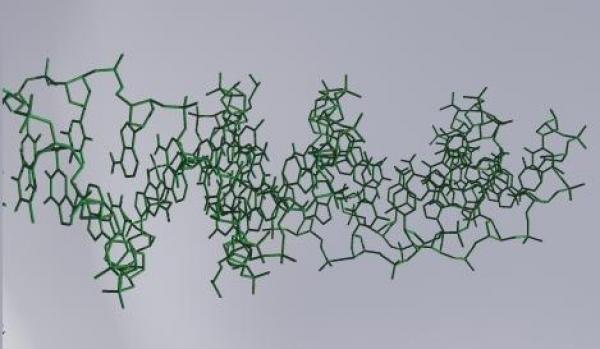BY LETTER
Organic Chemistry
 Image from Anders Sandberg |
Organic chemistry is the science that deals with the study, creation, and synthesis of hydrocarbon compounds, including those that make up the building blocks of life. It also studies the chemistry of organic molecules such as nucleic acids, and enzymes, both terragen and xenobiont. Advanced organic chemistry is one of the foundations of bionanotech.
Articles
- Amino Acid - Text by M. Alan Kazlev, with additions by Stephen Inniss
Any of a class of molecules that are combined to form proteins. - Ammonia - Text by M. Alan Kazlev
A colourless, pungent, corrosive gas, NH3, extensively used in the manufacture of crude organobiota and a wide variety of nitrogen-containing organic and inorganic products and chemicals. In is an important component in the atmosphere of some Jovian planets. - ATP (Adenosine Triphosphate) - Text by M. Alan Kazlev
A chemical compound that functions as an energy source for Terragen and a number of other biota, and is also widely employed in bionanotechnology. It has the formula C10H16N5O13P3. - ATPase - Text by M. Alan Kazlev
An enzyme responsible for converting electrical potential energy from a nanoscale battery into ATP; the molecule used for immediate fuel by virtually all Terragen biological life-forms, and the basis for the bionano molecular motor. Also called "The F0F1 Complex" and "ATP synthase." - Biodegradable - Text by M. Alan Kazlev
A substance that can be broken down through the normal activity of microorganisms. Many Zoeific, Arcadian, and some Genen, polities have strict guidelines and regulations regarding this. - Buckyball - Text by M. Alan Kazlev
Short for buckminsterfullerene, and part of a larger class of molecules known as as fullerenes, the third form of carbon. Any of a number of roughly spherical molecule formed of a large number of carbon atoms. The smallest and most common form of buckminsterfullerene is C60; it has 60 carbon atoms in a soccer-ball shape, but there are many variants. The third form of carbon. After atomic age visionary thinker and inventer R. Buckminster Fuller's building designs. - Carbon - Text by Steve Bowers
Non-metallic element with symbol C. - Carbon Nanotube - Text by M. Alan Kazlev
Elongated fullerene carbon molecule in a tubular configuration. Nanotubes are cylinders arranged from a single layer of carbon atoms. They are are 10 times stronger than, and have a fraction of the weight of, steel. - Cytosine - Text by M. Alan Kazlev
A nucleotide; one of the two pyrimidines in terragen organic life. In Terragen DNA it is paired with guanine, to make the base pair G-C. - Fullerene - Text by Stephen Inniss
Any molecule composed entirely of carbon, in the form of a hollow sphere, ellipsoid, or tube, as opposed to forms of carbon such as graphite or diamond which make extended networks that lead to crystals, or to amorphous forms of carbon such as soot. - Guanine - Text by M. Alan Kazlev
A nucleotide; one of the two purines in Terragen organic life. In DNA it is paired with cytosine to make the base pair G-C. - Non-biodegradable - Text by M. Alan Kazlev
Materials that are not broken down by natural microorganisms in the environment; they require special bionano or hylonano or artificial organisms that use the same to be disassembled or recycled. - Protein - Text by M. Alan Kazlev
Large organic molecule composed of one or more chains of amino acids, as determined by the base sequence of nucleotides in the gene coding for the protein. Proteins are required for the structure, function, and regulation of the cells, tissues, and organs of carbon-based life. Each protein has unique functions (e.g. hormones, enzymes, and antibodies). Protein engineering and Protein splicing are essential elements in biomeso and bionanotech. - Proteinoid - Text by M. Alan Kazlev
Cell-like, nonliving spheroid of protein molecules created in the laboratory by heating amino acids and adding water; an early step in the evolution of life. Widely used in biomesotech for creation of simple biomeso and bionano. - Thymine - Text by M. Alan Kazlev based on Hypermedia Glossary Of Genetic Terms
Pyrimidine base (nitrogenous base) and constituent of nucleotides and as such one member of the base pair A-T (adenine-thymine) in DNA.
Development Notes
Text by M. Alan Kazlev; modified by Stephen Inniss
Initially published on 13 December 2001.
Initially published on 13 December 2001.
Additional Information






